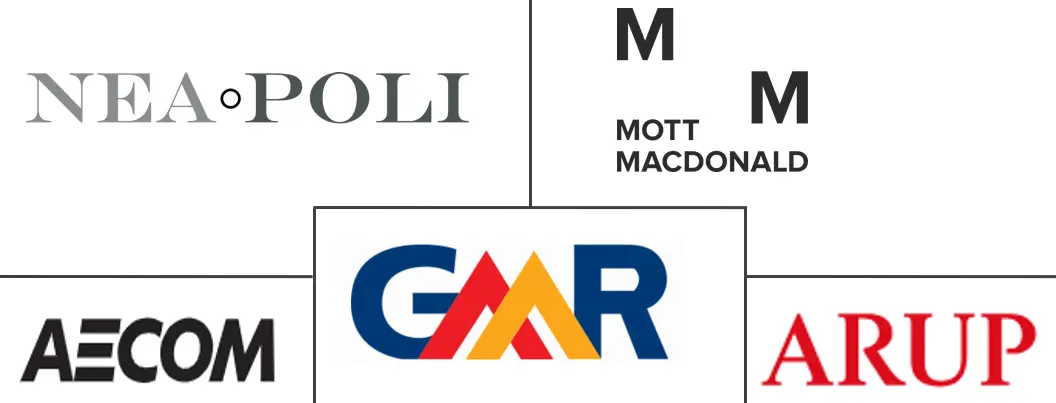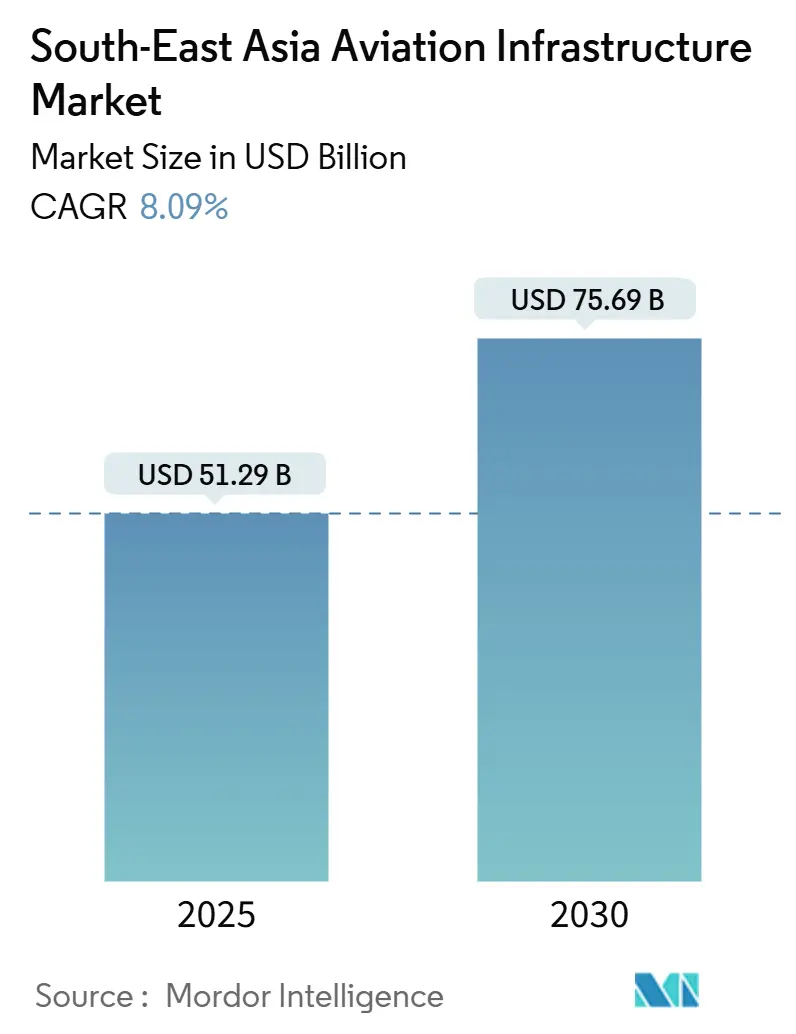
South-East Asia Aviation Infrastructure Market Analysis by Mordor Intelligence
The South-East Asia Aviation Infrastructure Market size is estimated at USD 51.29 billion in 2025, and is expected to reach USD 75.69 billion by 2030, at a CAGR of 8.09% during the forecast period (2025-2030).
Significant growth in terms of aviation infrastructure projects to meet Southeast Asia's future aviation requirements and the number of air traffic passengers, as well as aviation infrastructure projects to meet Southeast Asia's future aviation requirements, will lead the market to grow significantly in the coming years.
Moreover, growth in the number of commercial aircraft operations within the Southeast Asian countries will lead to aviation authorities entering into partnerships with established infrastructure companies to ensure the development of sustainable airport infrastructure projects capable of handling growing aviation requirements, thereby driving the market in the long run.
On the other hand, factors such as stringent regulations imposed by Southeast Asian aviation authorities will hamper market growth in the long run. In addition, the growing usage of artificial intelligence and blockchain technologies will increase business opportunities for aviation infrastructure companies in Southeast Asia, thereby leading the market to witness remarkable growth during the forecast period.
South-East Asia Aviation Infrastructure Market Trends and Insights
Terminal Segment Will Showcase Highest Growth During the Forecast Period
The growing demand for airport terminal construction projects, owing to the significant growth in commercial aviation operations within the region, is driving the market growth. In recent years, the Southeast Asian aviation industry has witnessed considerable growth due to increasing aviation operations and growing air traffic passenger numbers. Moreover, the growing need to improve intraregional connectivity within the region has led to a significant growth in the number of airport terminal constructions in Southeast Asia.
Moreover, various airport infrastructure companies are also focusing on constructing new and advanced airport terminals, which can help mitigate bottleneck issues while meeting the future requirements of the industry. For instance, in September 2023, Vietur Consortium, which Ic Ictas Construction leads, was awarded a contract by Vietnam's Long Thanh International Airport to construct the terminal building. The airport, which will be able to serve 100 million passengers per year upon its completion, has been underpinned by an investment of USD 1.5 billion for the first phase.
Similarly, in February 2024, Singapore announced the expansion of Changi Airport. The project, which includes adding a fifth passenger terminal and a third runway, is projected to cost approximately USD 10 billion. Upon completion, the Changi East development is expected to significantly enhance the airport's capacity by accommodating an extra 50 million passengers annually, bringing the total capacity to 140 million. Thus, rising expenditure on constructing new airports and modernization of existing airports boost the market growth across the region.
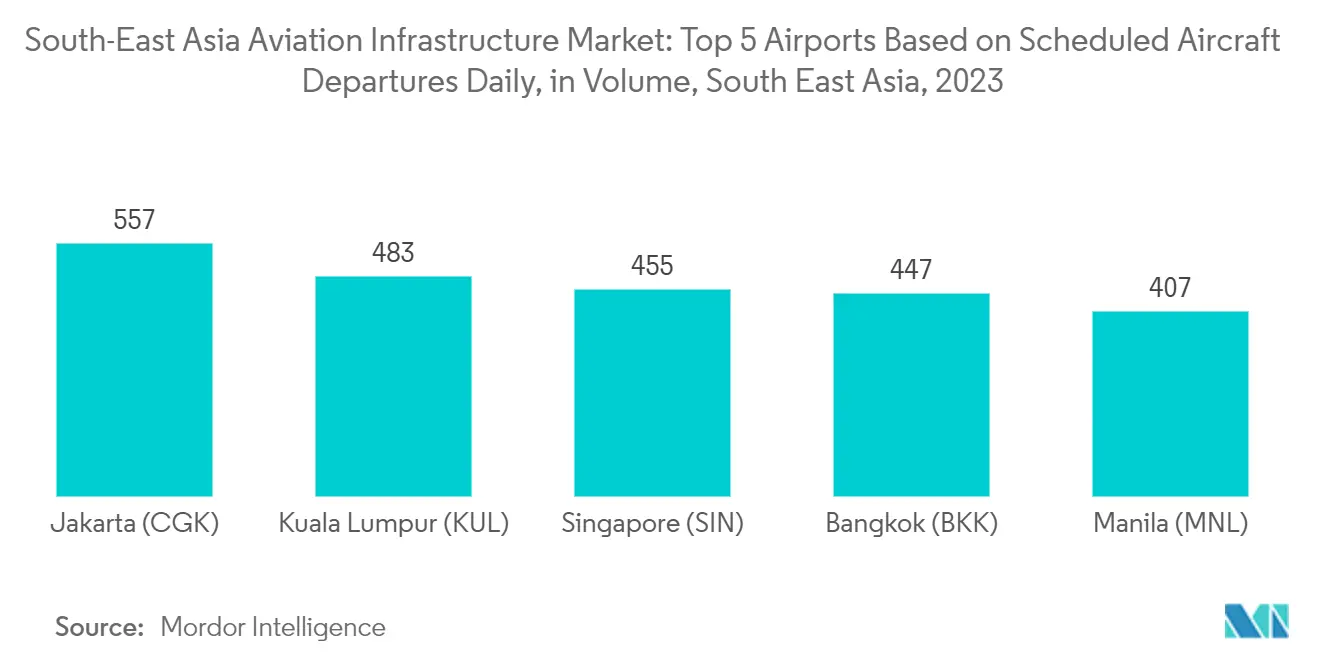
Malaysia Dominates the Market During the Forecast Period
Various factors, such as growth in aviation infrastructure projects within Malaysia owing to increased commercial aviation operations and the growing air passenger traffic, are anticipated to drive the market growth. Increasing air passenger numbers have led various air carriers in Malaysia to invest significantly in acquiring new and advanced commercial aircraft.
For instance, in January 2024, Malaysia Aviation Group (MAG) outlined its fleet modernization plan, which includes the induction of 12 new aircraft in 2024. One of the highlights is the arrival of the group's inaugural A330-900 (A330neo) in Q3 2024. Similarly, in February 2024, Boeing secured a contract with Thai Airways to deliver 45 B787 Dreamliners, supporting its plans to modernize its widebody fleet and grow its international routes.
Moreover, the country has also been witnessing substantial growth in different aviation infrastructure projects in recent years, which are intended to support the future development of Malaysia's aviation industry. For instance, in June 2023, the Ministry of Transport of Malaysia stated that the Kuala Lumpur International Airport will be upgraded by 2026 when the terminal will be nearing 90% of its annual capacity. Moreover, the terminal upgrade will be done in two phases. Thus, the significant increase in various infrastructure development projects witnessed in recent years is expected to generate noteworthy growth for aviation infrastructure in Malaysia during the forecast period.
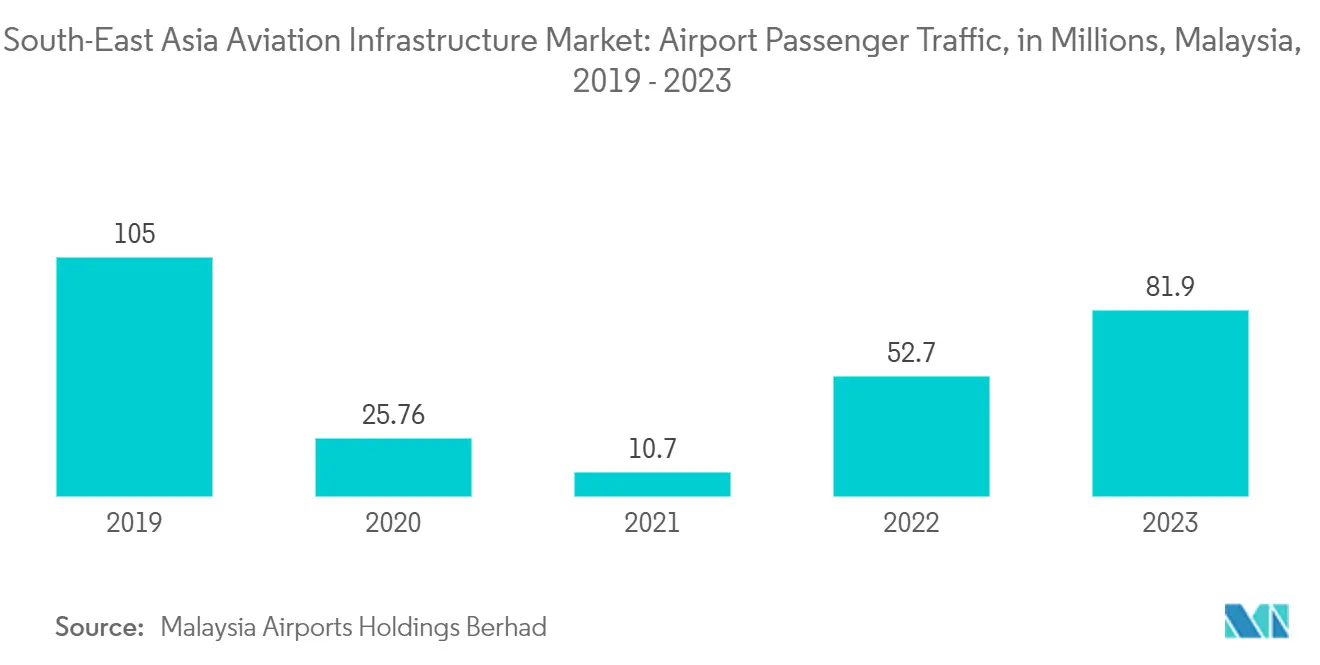
Competitive Landscape
The Southeast Asia aviation infrastructure market is consolidated, with a few players holding significant shares. Some prominent players in the market are GMR Infrastructure Limited, AECOM, Neapoli Sdn Bhd, Mott MacDonald Group Limited, and Ove Arup & Partners International Limited, among others.
Various aviation infrastructure companies in the Southeast Asian region are now focusing on timely project deliveries to grab significant market share and obtain long-term airport infrastructure development contracts. In addition, various players are now increasing their collaboration with airport authorities to understand and integrate their requirements within new airport construction projects. Furthermore, the growth in air passenger traffic and growing investments in airport infrastructure will lead to improvements in servicing the needs of the Southeast Asian aviation industry. It will also create new opportunities, driving the market's growth during the forecast period.
South-East Asia Aviation Infrastructure Industry Leaders
-
Neapoli Sdn Bhd
-
Mott MacDonald Group Limited
-
Ove Arup & Partners International Limited
-
GMR Infrastructure Limited
-
AECOM
- *Disclaimer: Major Players sorted in no particular order
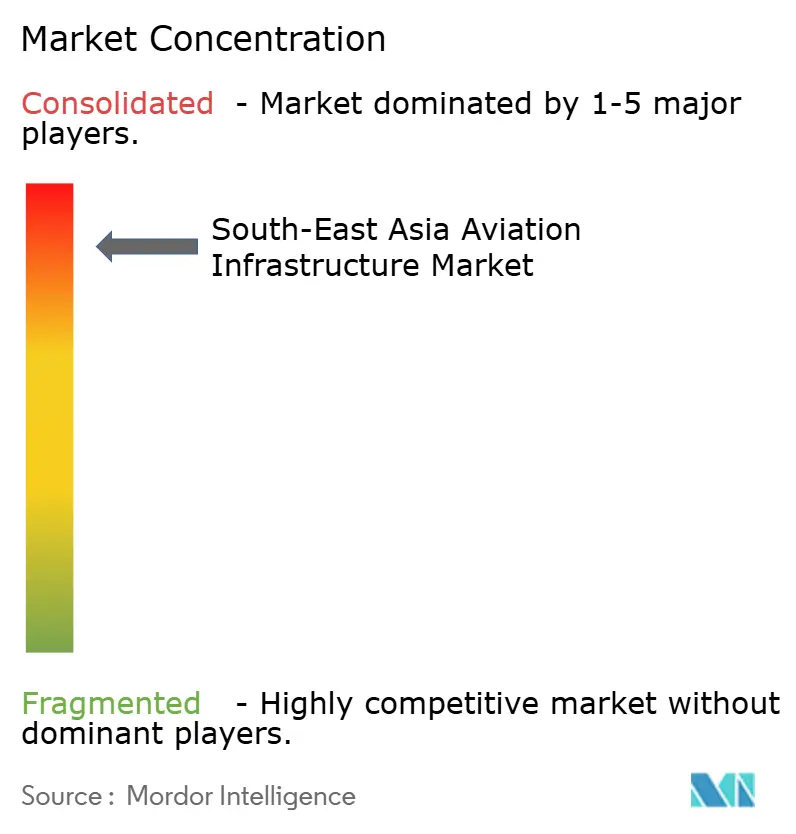
Recent Industry Developments
- May 2024: Airports of Thailand (AOT) announced that the feasibility studies for two upcoming international airports in Thailand, Andaman Airport in the South and Lanna Airport in the North, will be finalized this year. Construction is scheduled to commence by 2027.
- November 2023: The Indonesian government announced that new airport construction is underway in the new capital city of Nusantara, valued at USD 273 million.
South-East Asia Aviation Infrastructure Market Report Scope
Southeast Asian aviation infrastructure refers to all the construction groups, passenger terminals, landing strips, taxiways, platforms, parking spaces, internal access roads, equipment and installations, and civil works that make up the airports in Southeast Asia.
The Southeast Asia aviation infrastructure market is segmented based on airport type, infrastructure type, and geography. By airport type, the market is classified into commercial airports and military airports. By infrastructure type, the market is divided into the terminal, control tower, and other infrastructure types. Other infrastructure types include maintenance facilities, fire and rescue facilities, taxiways and runways, aprons, and hangars. The report also covers the market sizes and forecasts for the South-East Asia aviation infrastructure market in major countries across different regions. For each segment, the market size is provided in terms of value (USD).
| Commercial Airport |
| Military Airport |
| Terminal |
| Control Tower |
| Other Infrastructure Types |
| Malaysia |
| Philippines |
| Singapore |
| Vietnam |
| Indonesia |
| Thailand |
| Rest of South-East Asia |
| Airport Type | Commercial Airport |
| Military Airport | |
| Infrastructure Type | Terminal |
| Control Tower | |
| Other Infrastructure Types | |
| Geography | Malaysia |
| Philippines | |
| Singapore | |
| Vietnam | |
| Indonesia | |
| Thailand | |
| Rest of South-East Asia |
Key Questions Answered in the Report
How big is the South-East Asia Aviation Infrastructure Market?
The South-East Asia Aviation Infrastructure Market size is expected to reach USD 51.29 billion in 2025 and grow at a CAGR of 8.09% to reach USD 75.69 billion by 2030.
What is the current South-East Asia Aviation Infrastructure Market size?
In 2025, the South-East Asia Aviation Infrastructure Market size is expected to reach USD 51.29 billion.
Who are the key players in South-East Asia Aviation Infrastructure Market?
Neapoli Sdn Bhd, Mott MacDonald Group Limited, Ove Arup & Partners International Limited, GMR Infrastructure Limited and AECOM are the major companies operating in the South-East Asia Aviation Infrastructure Market.
What years does this South-East Asia Aviation Infrastructure Market cover, and what was the market size in 2024?
In 2024, the South-East Asia Aviation Infrastructure Market size was estimated at USD 47.14 billion. The report covers the South-East Asia Aviation Infrastructure Market historical market size for years: 2020, 2021, 2022, 2023 and 2024. The report also forecasts the South-East Asia Aviation Infrastructure Market size for years: 2025, 2026, 2027, 2028, 2029 and 2030.
Page last updated on:
South-East Asia Aviation Infrastructure Market Report
Statistics for the 2025 South-East Asia Aviation Infrastructure market share, size and revenue growth rate, created by Mordor Intelligence™ Industry Reports. South-East Asia Aviation Infrastructure analysis includes a market forecast outlook for 2025 to 2030 and historical overview. Get a sample of this industry analysis as a free report PDF download.
